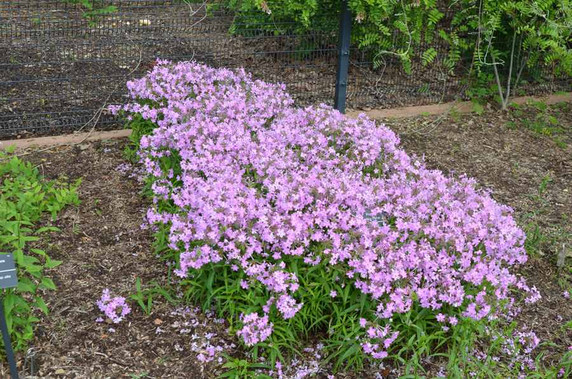Phlox carolina ssp. carolina 'Kim' - CAROLINA PHLOX 'KIM' (shorter, early & healthy)
Healthy and early blooming, mid-sized phlox, discovered in natural plant communities in Alabama.
Sturdy stems, lighter green clean leaves, high coverage with flowers, good for butterflies and hummingbirds.
One of the top performers at Mt. Cuba Phlox for sun trials, gaining 4.5 points out of 5.
Blooming Time: late May - mid June
Size: 24" tall x 24-36" wide, spacing 1-1.5'. In time forms wide cllumps - leave some space for it
USDA Zones: 5 to 9
Culture: full sun, half sun, half shade to light dappled shade. Grows well in average garden soil, loam, and clayish soil. Adaptable to soil typs and moisture
Moisture Needs: average (medium), medium-moist
Origin: Discovered and introduced by plantsman Jan Midgley from a wild population in Alabama. In nature Phlox carolina occupies woodland openings and edges, usually on slightly acidic or richer soils, loams and even sands. Usually on slighlty moist soils. Phlox carolina ssp. carolina is native to southeastern and souther states, see the USDA distribution map.
Deer/Rabbit Resistant: no / no (needs some protection)
Attracts Butterflies or Pollinators: butterflies, sphinx moths (hummingbird moth)
Attracts Hummingbirds: yes
Pot Size: square 3.5" x 4" deep perennial pot
Plant combinations: Excellent in flower borders, bigger containers, woodland edges, half shade and difficult "transition zones" in the garden (that get some sun and som shade too). Can be combined withmany common perennials, natives and cultivars of natives. Good companions can be for example
can be Actaea (Cimicifuga), Aquilegia, Asters, Alchemilla, Chelone, Chrysogonum, Coreopsis verticillata, Dicentra, Echinacea, Euphorbia, hardy Geranium, Geum, Heuchera, Iris sibirica, Monarda, tall Phlox, Physostegia, Rudbeckia, Spigelia, Veronicastrum, grasses like Calamagrostis, Panicum or Carex (sedges).
Picture copyright: Mt Cuba Center

Phlox carolina ssp. carolina 'Kim' - CAROLINA PHLOX 'KIM' (shorter, early & healthy)
Healthy and early blooming, mid-sized phlox, discovered in natural plant communities in Alabama.
Sturdy stems, lighter green clean leaves, high coverage with flowers, good for butterflies and hummingbirds.
One of the top performers at Mt. Cuba Phlox for sun trials, gaining 4.5 points out of 5.
Blooming Time: late May - mid June
Size: 24" tall x 24-36" wide, spacing 1-1.5'. In time forms wide cllumps - leave some space for it
USDA Zones: 5 to 9
Culture: full sun, half sun, half shade to light dappled shade. Grows well in average garden soil, loam, and clayish soil. Adaptable to soil typs and moisture
Moisture Needs: average (medium), medium-moist
Origin: Discovered and introduced by plantsman Jan Midgley from a wild population in Alabama. In nature Phlox carolina occupies woodland openings and edges, usually on slightly acidic or richer soils, loams and even sands. Usually on slighlty moist soils. Phlox carolina ssp. carolina is native to southeastern and souther states, see the USDA distribution map.
Deer/Rabbit Resistant: no / no (needs some protection)
Attracts Butterflies or Pollinators: butterflies, sphinx moths (hummingbird moth)
Attracts Hummingbirds: yes
Pot Size: square 3.5" x 4" deep perennial pot
Plant combinations: Excellent in flower borders, bigger containers, woodland edges, half shade and difficult "transition zones" in the garden (that get some sun and som shade too). Can be combined withmany common perennials, natives and cultivars of natives. Good companions can be for example
can be Actaea (Cimicifuga), Aquilegia, Asters, Alchemilla, Chelone, Chrysogonum, Coreopsis verticillata, Dicentra, Echinacea, Euphorbia, hardy Geranium, Geum, Heuchera, Iris sibirica, Monarda, tall Phlox, Physostegia, Rudbeckia, Spigelia, Veronicastrum, grasses like Calamagrostis, Panicum or Carex (sedges).
Picture copyright: Mt Cuba Center





